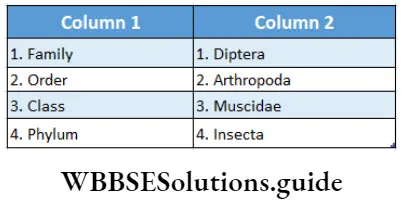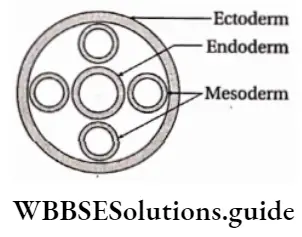Animal Kingdom Multiple Choice Questions
Question 1. An important characteristic that Hemichordates share with Chordates is
- Ventral tubular nerve cord
- Pharynx with gill slits
- Pharynx without gill slits
- Absence of notochord
Answer: 2. Pharynx with gill slits
Question 2. Which of the following represents the order of horses?
- Perissodactyla
- Caballus
- Ferus
- Equidae
Answer: 1. Perissodactyla
Read and Learn More WBCHSE Multiple Choice Question and Answers for Class 11 Biology
Question 3. Which among these is the correct combination of aquatic mammals?
- Dolphins, Seals, Trygon
- Whales, Dolphins, Seals
- Trygon, Whales, Seals
- Seals, Dolphins, Sharks
Answer: 2. Whales, Dolphins, Seals
Animal kingdom multiple choice questions with answers PDF
Question 4. In the case of poriferans, the spongocoel is lined with flagellated cells called
- Oscula
- Choanocytes
- Mesenchymal cells
- Ostia
Answer: 2. Choanocytes

Question 6. Which of the following characteristics is not shared by birds and mammals?
- Breathing using lungs
- Viviparity
- Warm-blooded nature
- Ossified endoskeleton
Answer: 2. Viviparity
Question 7. Which of the following features is not present in the phylum Arthropoda?
- Metameric segmentation
- Parapodia
- Jointed appendages
- Chitinous exoskeleton
Answer: 2. Parapodia
Question 8. Which of the following structures is homologous to the wing of a bird?
- Wing of a moth
- Hind limb of a rabbit
- Flipper of whale
- The dorsal fin of a shark
Answer: 3. Flipper of whale
Question 9. Match column I with column II for housefly classification and select the correct option using the codes given below:

- 1-3.2-1,3-4,4-2
- 1-3,2-2,3-4,4-1
- 1-4,2-3,3-2,4-1
- 1-4,2-2,3-1,4-3
Answer: 1. 1-3.2-1,3-4,4-2
Question 10. Choose the correct statement.
- All mammals are viviparous
- All cyclostomes do not possess jaws and paired fins
- All reptiles have a three-chambered heart
- All Pisces have gills covered by an operculum
Answer: 2. All cyclostomes do not possess jaws and paired fins
Question 11. The body having meshwork of cells, internal cavities lined with food-filtering flagellated cells, and indirect development are the characteristics of phylum—
- Protozoa
- Coelenterata
- Porifera
- Mollusca
Answer: 3. Porifera
Class 11 biology animal kingdom MCQ with solutions
Question 12. A jawless fish, that lays eggs in fresh water and whose ammocoetes larvae after metamorphosis return to the ocean is—
- Petromyzon
- Eptatretus
- Myxine
- Neomyxine
Answer: 1. Petromyzon
Question 13. Select the taxon mentioned that represents both marine and freshwater species—
- Echinoderms
- Ctenophora
- Cephalochordata
- Cnidaria
Answer: 4. Cnidaria
| Class 11 Biology | Class 11 Chemistry |
| Class 11 Chemistry | Class 11 Physics |
| Class 11 Biology MCQs | Class 11 Physics MCQs |
| Class 11 Biology | Class 11 Physics Notes |
Question 14. Planaria possesses the high capacity of—
- Metamorphosis
- Regeneration
- Alternation of generation
- Bioluminescence
Answer: 2. Regeneration
Question 15. A marine cartilaginous fish that can produce electric current is—
- Pristis
- Torpedo
- Trygon
- Scoliodon
Answer: 2. Torpedo
Question 16. Which one is an example of a living fossil?
- Coral
- Ascidia
- Octopus
- King crab
Answer: 4. King crab
Question 17. Juvenile hormone in insect is released from—
- Protocerebrum
- Corpora cardiaca
- Corpora allata
- Thoracic gland
Answer: 3. Corpora allata
Question 18. The body of the rohu fish is covered by—
- Cycloid scale, but the tail is homocercal
- Placoid scale, but the tail is heterocercal
- Cycloid scale, but the tail is heterocercal
- Placoid scale, but the tail is homocercal
Answer: 1. Cycloid scale, but the tail is homocercal
Question 19. Which of the following statement(s) regarding coelenterates is/are wrong?
- Cnidocytes are present on the tentacles and on the body.
- Diploblastic with the cellular level of organization.
- Polyp forms are free swimming.
- Exhibits metagenesis.
- Polyps produce medusae sexually and medusae form polyps asexually
Choose the correct option
- 2 and 4
- 3 and 5
- 1,2 and 3
- only 3
- 2,3 and 5
Answer: 5. 2,3 and 5
Important MCQs on animal kingdom for competitive exams
Question 20. Choose the wrong statement.
- Teeth in Chondrichthyes are modified ctenoid scales
- Air bladder in fish regulates buoyancy
- In amphibians, the tympanum represents the ear
- Long bones in birds are pneumatic
- Reptiles are poikilotherms
Answer: 1. Teeth in Chondrichthyes are modified ctenoid scales
Question 21. The kind of coelom represented in the diagram given below is characteristic of—

- Earthworm
- Cockroach
- Roundworm
- Tapeworm
Answer: 3. Roundworm
Question 22. The cellular organization of the body is present in
- Annelida
- Platyhelminthes
- Porifera
- Urochordata
Answer: 3. Porifera
Question 24. Oviparous mammal is—
- Equus
- Macropus
- Ornithorhynchus
- Pteropus
Answer: 3. Ornithorhynchus
Question 25. Which of the following animals has anucleated erythrocytes?
- Earthworm
- Sepia
- Frog
- Rat
Answer: 4. Rat
Question 26. The central hollow portion of the vertebra is called—
- Neural canal
- Central canal
- Auditory canal
- Vertebro-arterial canal
Answer: 1. Neural canal
Question 27. Pneumatic bones are present in
- Macropus
- Psittacula
- Chelone
- Balaenoptera
Answer: 2. Psittacula
Question 28. The life cycle of a parrot is about
- 15 years
- 50 year
- 25 years
- 140 years
Answer: 4. 140 years
Question 29. In the cycle of Ascaris lumbricoides rhabditiform larva undergoes 2nd and 3rd moultings in—
- Moultings in
- Heart
- Alveoli of lungs
- Small intestine
Answer: 3. Alveoli of lungs
Question 30. A molluscan with calcareous spicules is—
- Lepidoplenrus
- Doris
- Neopilina
- Chaetoderma
Answer: 4. Chaetoderma
Question 31. With reference to Phylum-Echinodermata, identify the classes that have Pedicillariae—
- Crinodea and Holothuroidea
- Holothuroidea and Echinoidea
- Asteroidea and Echinoidea
- Ophiuroidea and Holothuroidea
Answer: 3. Asteroidea and Echinoidea
Question 32. Assertion (A): Lancelets are jawless, primitive fish-like vertebrates.
Reason (R): In lancelets notochord, tubular nerve cord, and pharyngeal gills slits are present throughout their life.
- A is correct, but R is incorrect
- A is incorrect, but R is correct
- Both A and R are correct and R is the correct explanation for A
- Both A and R are correct and R is not the correct explanation for A
Answer: 4. Both A and R are correct and R is not the correct explanation to A
Question 33. Proteus anguinus is an example of—
- Circular rhythms
- Effect of light pigmentation
- Phototaxis
- Photokinesis
Answer: 2. Effect of light pigmentation
Question 34. Intra-abdominal tests are found in—
- Panthera and Equuas
- Macaco and Macropus
- Baleonoptera and Delphinus
- Canis and Felis
Answer: 3. Baleonoptera and Delphinus
Question 35. Radula is found in
- Pila sp
- Chiton sp
- Lamellidens sp
- Pinctada sp
Answer: 1. Pila sp
Question 36. Retrogressive metamorphosis occurs in—
- Hemichordata
- Cephalochordata
- Urochordata
- Vertebrata
Answer: 3. Urochordata
Question 37. Assertion (A): An open circulatory system is found in most arthropods.
Reason (R): Arthropods contain hemolymph which directly bathes internal tissues and organs.
- Both A and R are correct and R is the correct explanation of A
- Both A and R are correct, but R is not the correct explanation of A
- A is correct, but R is incorrect
- Both A and R are incorrect
Answer: 1. Both A and R are correct and R is the correct explanation of A
Quiz on animal kingdom with correct answers
Question 38. The chordate features shared by the non-chordates are—
- Bilateral symmetry
- Triploblastic condition and bilateral symmetry
- Metamerism
- All of the above
Answer: 2. Triploblastic condition and bilateral symmetry
Question 40. In Polychaeta, the setae are—
- Numerous
- Singly arranged in bundles
- Radially arranged in bundles
- Fused
Answer: 1. Numerous
Question 41. Choanocytes are present in—
- Coelenterata
- Porifera
- Echinodermata
- Mollusca
Answer: 2. Porifera
Question 42. Veliger larva occurs in phylum—
- Mollusca
- Echinodermata
- Arthropoda
- Cnidaria
Answer: 1. Mollusca
Question 43. Ostia is present in—
- Coelenterate
- Platyhelminthes
- Annelids
- Sponges
Answer: 4. Sponges
Question 44. Pentaradial symmetry is found in—
- Echinodermata
- Annelida
- Porifera
- Arthropoda
Answer: 1. Echinodermata
